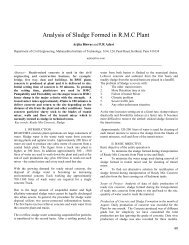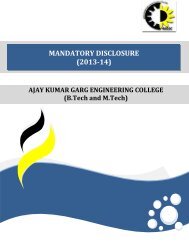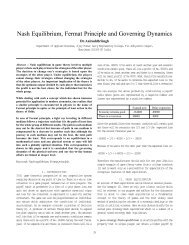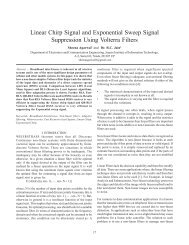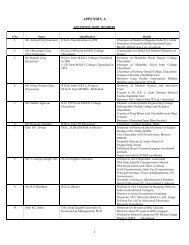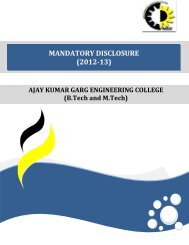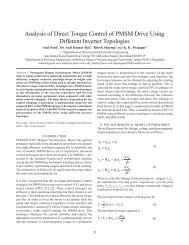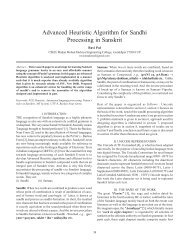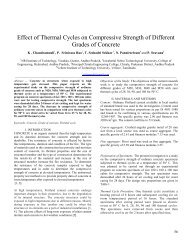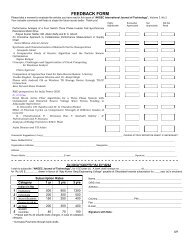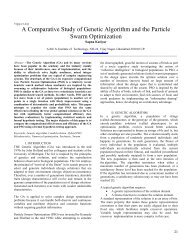Architectural designs and Constructability Issues
Architectural designs and Constructability Issues
Architectural designs and Constructability Issues
You also want an ePaper? Increase the reach of your titles
YUMPU automatically turns print PDFs into web optimized ePapers that Google loves.
ARCHITECTURAL DESIGN ISSUES<br />
The incomplete specifications factor is the second most<br />
important factor shown in diagram 6 that causes<br />
constructability problems. If construction personnel are<br />
involved in the preparation of specifications, many on-site<br />
conflicts can be avoided. The construction industry is a<br />
fragmented industry where different parties such as the owner,<br />
contractor, designer, <strong>and</strong> subcontractors have differing <strong>and</strong><br />
sometimes conflicting objectives. This fragmentation is<br />
particularly prevalent in the traditional designbid-build project<br />
delivery system where adversarial relationships among the<br />
parties has become the norm. The lack of trust, the existence of<br />
conflicting objectives, <strong>and</strong> the common expectation of frequent<br />
disagreements result in a general lack of communication which<br />
in turn creates constructability problems [2].<br />
The respondents listed budgetary limitations, resistance of<br />
the owner to formal constructability programs, <strong>and</strong><br />
nonst<strong>and</strong>ardization of design to be the least influential<br />
constraints that hinder constructability (Figure 8). This finding<br />
challenges the common perception that owners constitute a<br />
barrier to formal constructability programs because<br />
constructability programs add a highly visible extra cost to<br />
projects, <strong>and</strong> benefits are less tangible. The findings suggest<br />
that there is no tendency on the part of the owners to prevent<br />
constructability programs, probably because of their proven<br />
cost savings.<br />
Benefits of constructability reviews: A constructability program<br />
introduces a cost that is usually added to the design fee <strong>and</strong><br />
might harm the competitiveness of the firm. Some firms absorb<br />
that cost into their indirect expenses to stay competitive, so<br />
there should be some benefits to the design firms in return for<br />
their investment in a more buildable design.<br />
The most significant benefits listed by respondents are<br />
developing better relationships with clients <strong>and</strong> contractors,<br />
being involved in fewer lawsuits, <strong>and</strong> building a good<br />
reputation(Figure 9).<br />
This finding indicates that long-term public relations, litigation<br />
free jobs, <strong>and</strong> the building of a good reputation are crucial<br />
considerations for design professionals, possibly because<br />
design work is typically not awarded through lowest offer<br />
bidding but by a client who approaches a reputable <strong>and</strong><br />
competent designer <strong>and</strong> negotiates an agreement.<br />
A reduction in the number of potential claims <strong>and</strong> lawsuits<br />
against the design firm was marked as the second reward of<br />
constructability. This finding can be explained by the fact that<br />
design errors (lack of constructability) are the most common<br />
cause for contract claims [2].<br />
The construction business is extremely risky. Much of the<br />
preparatory paperwork that precedes construction projects can<br />
be viewed as the formulation of risk allocation between the<br />
Figure 9. Rate the following with respect to benefits of<br />
constructability reviews to the design firm (A. Reduction in number<br />
of claims & lawsuits against designer, B. Better reputation <strong>and</strong> more<br />
workload, C. Improved efficiency of design, D. Professional<br />
satisfaction, E. Better relationship with contractor <strong>and</strong> client).<br />
owner, contractor, <strong>and</strong> designer. As claims <strong>and</strong> disputes<br />
increase, the construction industry struggles to find a way to<br />
equitably <strong>and</strong> economically resolve them. A study indicated<br />
that fees paid to lawyers <strong>and</strong> experts in litigation had increased<br />
425% between 1979 <strong>and</strong> 1990; whereas, settlements <strong>and</strong> verdicts<br />
had increased only 309%. As a result, the threat of litigation<br />
stifles innovation in engineering design. Even as they assess<br />
risk carefully on a project-by-project basis, many designers<br />
turn down work because of the threat of liability. This shows<br />
that the threat of litigation is an important factor in the design<br />
profession.<br />
<strong>Constructability</strong> issues & <strong>Architectural</strong> aspects: It was<br />
logical, then, there be a survey done related to architectural<br />
<strong>designs</strong> <strong>and</strong> constructability issues directly; The findings<br />
presented in figure 10 are most important Datas in the<br />
questionnaire so indicate rate of architectural aspects against<br />
the type of constructability problems respectively <strong>and</strong> the<br />
respondents using these aspects in firms <strong>and</strong> organizations.<br />
In this part a list of constructability problems which are the<br />
most important related to architectural problematic aspects are<br />
collected.<br />
The most significant factor selected by the respondents is<br />
area of architectural drawings(95%), which problems happen<br />
mostly in the Construction Industry, which indicated that the<br />
number of construction problems involved in a constructability<br />
program are depend on process of providing the drawings,<br />
<strong>and</strong> as a result this is depend out on the lack of details <strong>and</strong> 3d<br />
shaping <strong>and</strong> forming of the concepts. In this area architectures<br />
must focus favorably.<br />
15



